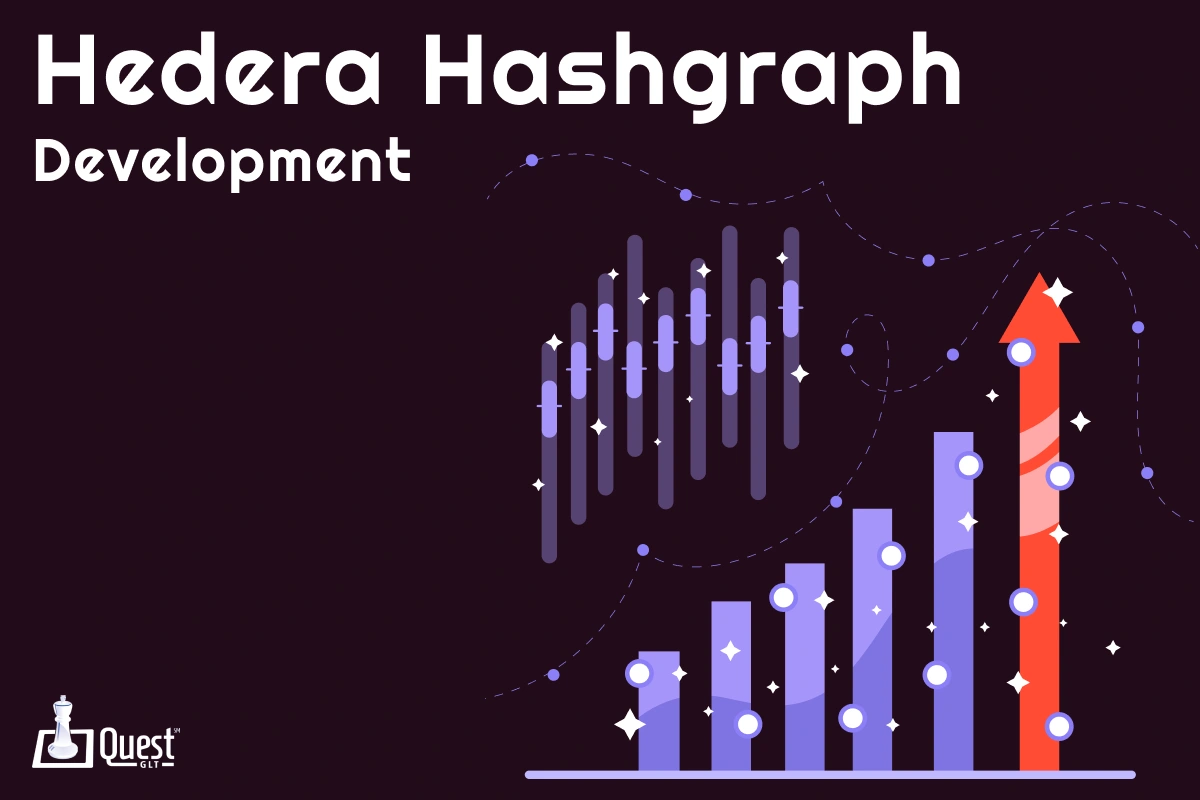
These days majority of blockchain projects rely on mining, a highly energy-intensive method that causes several environmental issues by requiring computers to operate extremely difficult computations to authenticate transactions. Hedera Hashgraph pleads that it will solve the mining issues by substituting it with a completely new ledger technology.
Is Hedera able to boost this? To learn more, continue reading!
Hedera is a publicly accessible distributed ledger and governance framework developed from the ground up to help existing operational web-scale applications. Distributed ledger technologies allow developers to create computational trust straight into their applications.
Hedera is distinct in that it surpasses the most popular public blockchains (like Ethereum or Bitcoin) in terms of speed, righteousness, energy efficiency, stability, and safety while still accomplishing the same objective. These benefits are attributable to the international enterprise governing body, which now owns and runs Hedera, as well as the underlying hashgraph concurrence method.
A sense that it is developed on a series of blocks, hashgraph is not a blockchain. It enables us to see it as a graph, where numerous transactions added to the network improve the speed at which transactions are verified.
The technology name is based on DAG, short for Directed Acyclic Graph. With the use of this technology, Hedera Hashgraph earns more than 100,000 transactions every second, effectively competing with Visa and other mass-market payment methods.
Every day 6.5 million transactions are concluded on the Hedera network, with an average transaction time of 5 seconds. Easily surpasses the combined 300,000 transactions for Bitcoin and 1.2 million transactions for Ethereum.
Isn't that the ultimate goal of a blockchain network? So, now understand what makes Hedera unique!
The three unique qualities of the Hedera Hashgraph:
-
Fair: It uses the uniform time-stamping technique that makes it more equitable than compared to all other algorithms.
-
Secure: With an asynchronous Byzantine Fault Tolerant System (ABFT), no member can stop the community from reaching a consensus or changing it once established.
-
Speed: It can handle more than hundreds of thousands of transactions and verify over a million signatures per second.
How Does Hedera Hashgraph Work?
Hedera is a public network of enterprise-grade that works using a graphical method to facilitate communication between all the nodes inside the same architecture. Two major protocols, which are listed below, mainly rely on the storage of data.
The Hedera Hashgraph protocols are:
-
Gossip
One of the well-known concepts in networking is Gossip. By transferring the information from one node to another, this protocol brings consensus to the network.
The platform and software that will operate on millions of nodes worldwide are governed by a council of 19 multinational firms globally. Nodes on the Hashgraph converse with one another, comparing notes on the network’s transaction history, to reach a consensus, rather than mining.
Some nodes are chosen by notable spectators, they remark. During this process, these observers gain fame since the nodes are apprised of every witness occurrence or transaction at an early stage. The chosen nodes then compare these well-known witnesses' rumours with those that are circulating in most other nodes.
During the gossiping, the nodes choose a few well-known witnesses. Due to their early communication to the nodes, each of these witnesses—which are events or transactions—become well-known. Following that, the selected nodes compare the rumours spread by most nodes concerning these well-known witnesses.
-
Virtual Voting
Based on the Gossip protocol, every node in the graphical structure would be aware of each piece of data that every other node possessed. This also results in a virtual voting process that allows a member to learn about every member's voting details.
Virtual voting is the process by which a node determines whether the transaction is valid or not. If any transaction is considered valid it receives the support of 2/3rd of the network’s node as a witness. The method would continue to work even if a third node turned Byzantine due to the Byzantine Fault Tolerant System being the foundation of hashgraph. Voting occurs over several rounds.
In the future, Hedera is preparing to create permissionless mainnet nodes to facilitate more users to participate in transaction verification and protect the network from external invasions.
Pros and Cons of Hedera Hashgraph
Directed acyclic graphs and asynchronous byzantine fault tolerance have numerous intricate details. To get down to earth, let's cut through the technical language and discuss the pros and cons of the Hedera Network.
Pros
-
Fast – Processing over 10,000 transactions every second, Hedera Hashgraph makes it among the most performant Layer-1 networks.
-
Affordable – Regardless of HBAR pricing and network congestion, every transaction on the Hedera network will cost the customer less than one cent.
-
Energy efficient – To go fully carbon-negative, the Hedera Hashgraph network uses significantly less power than traditional blockchains and has implemented carbon-offsetting initiatives.
-
Constant growth – On the Hedera mainnet, more than 1.9 million accounts were created with new ones being added every day.
-
Accessible – The Hedera network is EVM-compatible, so anybody who has used Ethereum in the past will be comfortable with its interface. Additionally, there is less difficulty for developers to transfer Ethereum-based decentralised applications to the Hedera network.
Cons
-
Hedera’s decentralized is not as complete as it seems – The Hedera Governing Council still decides who is permitted to run a node on the network. One may also contend that Swirlds, the business responsible for creating the hashgraph, has more authority, influence, and control over the network's future.
-
Undeveloped ecosystem – The Hedera network has few decentralized apps developed on it, despite its rank as one of the top 50 cryptocurrencies in terms of market capitalization. There are only six DeFi applications available on the network, according to DeFiLlama.
Hedera Hashgraph Development
The leading Hedera Hashgraph development company, Quest GLT a prominent provider of Hedera Hashgraph development services, offers a wide range of customizable business applications. We have a dedicated team of developers who are proficiency in developing Hedera Hashgraph applications since we are aware of the network's full potential and the market's present need for it. The following are a few of our main services for developing Hedera Hashgraph networks.
Hedera’s Four Main Offeirngs
The power & capability of Hedera Hashgraph is that it has set up more than a single service solution that can help the development & operation of decentralized apps (dApps) & networks. At the core of its offerings are four main services: At the core of its offerings are four main services:
-
Smart Contracts
These features automatically translate into logic execution which allows developers to create various dApps & deploy them through different industries and cases, among others. This feature helps cut down time & consolidates processes for easier preservation & provides automation to the system.
-
Token Service
It gives the users access to a unified environment of creating, conducting, & administering both real & non-realized tokens in the network of Hedera. The combination of smart contracts & digital assets allows an easy way to tokenize their assets and hold them through digital platforms. This opens many new doors like digital asset exchange or representation.
-
Consensus Service
The main purpose of this service is to reach this target: a rapid, fair and secure consensus, which is necessary in trust-required scenarios. With the Hedera Consensus Service (HCS) approach, the developer can add a trust layer within all their apps, permissioned network, or any other message logs ensuring their immutability and verifiability.
-
HBAR
This tends to fulfil two goals in (within) Hedera's ecosystem. Cryptocurrency functions mainly as the native currency for which the platform can execute supremely customized and inexpensive deals. Moreover, HBAR holds a key position in network security since the Users can stake their tokens for providing the necessary maintenance to make the platform more strong and stable..
Applications Developed Using Hedera Hashgraph
Some of the well-known applications that use the Hedera Hashgraph algorithm are listed below:
-
Sagewise - Hedera Hashgraph was used to develop Sagewise, a finance industry-based DApp.
-
Carbon - This is a stablecoin developed using Hedera Hashgraph
-
Hearo - Hedera is a music marketplace platform that supports Hedera Hashgraph.
-
Alto - It is a gaming NFT that was created using Hedera Hashgraph.
-
Cryptotask - An online marketplace designed specifically for cryptocurrency payments
The Future Prospects of Hedera Hashgraph
The Hashgraph, which has been in the making for a year and a half, stands out from existing distributed ledger technologies (DLTs) in numerous ways. According to its investors, it works more effectively than blockchains, which makes it more appropriate for businesses and trade. Similar to how they refer to Bitcoin as first generation and Ethereum as second generation, they also refer to the Hashgraph as a third generation public ledger.
The Hedera Token Service was launched by Hedera in February, allowing users to generate tokens on the platform and it will cost just $0.001 for transferring tokens.
According to its roadmap, the Hedera Hashgraph mainnet will get several upgrades over the coming months. Plans are in place to lessen the amount of downtime that the network requires for maintenance, allowing for sharding and the processing of transactions by different parties.
Hedera is setting the standard for public ledgers of the future with its combination of quick throughput, cheap prices, and finality seconds.
Whatever you think of it, Hedera is undoubtedly pursuing ambitious goals.
Why Choose Quest GLT Hedera Hashgraph Development Company?
Quest GLT is a well-known Hedera Hashgraph development company that provides a wide range of Hedera Hashgraph development services for businesses of all sizes.
-
Remarkable portfolio
The development team of Quest GLT has years of experience working with well-known companies globally, they have built a strong and remarkable portfolio.
-
Impenetrable security
Our Asynchronous Byzantine Tolerance Algorithm-based apps and solutions provide you access to a highly robust and secure Hashgraph environment.
-
Complete assistance
Throughout your journey, from problem-pitching to solution execution, implementation, launch, and after-sales, we aim to provide comprehensive technical and consulting help.
-
Quick response
Our clients obtain the Hedera Hashgraph dApps, APIs, smart contracts, etc. solutions in a timeline that matches their plan, which is one of the reasons our services are so well-respected.
Develop Customised and Secure Solutions with Our Established Frameworks
-
Aptos - A high-performance, byzantine fault-tolerant based PoS blockchain framework designed for quick and safe execution.
-
Solana - This blockchain platform is designed to support large-scale DApps.
-
NEAR Protocol - This blockchain framework is designed for decentralized applications.
-
Ethereum - Ethereum is a fully decentralized Blockchain Technology Platform that facilitates the development of smart contracts and the building of decentralised applications.
-
Binance Smart Chain - A high-performance blockchain network developed using technology that is compatible with the Ethereum Virtual Machine (EVM).
-
Polygon - It is a Layer 2 scaling solution that aims to solve scalability, high fees, and slow transaction speed issues on the Ethereum network.
-
Avalanche - Avalanche is an EVM blockchain with high performance that facilities DApps and smart contracts.
-
Hyperledger - For their unique business requirements, enterprises may design and oversee private, permissioned blockchain networks using Hyperledger.
-
Hedera Hashgraph - Quest GLT has expertise in utilising the Hedera Hashgraph technology to create blockchain applications.
-
Stellar - Stellar is a decentralised, open-source blockchain network that enables quick processing times, cheap transaction costs, and cross-border asset transfers.
Summing Up
At Quest GLT, we use the Hedera Hashgraph’s power to create scalable, fast, and safe decentralized applications. Our proficiency in establishing connections with Hedera guarantees that your dApps make the most of this ground-breaking technology. Work together with us to realise your decentralised vision and get the rewards of Hedera Hashgraph.
Visit Also :- Top 10 Trusted Blockchain Development Companies in USA













